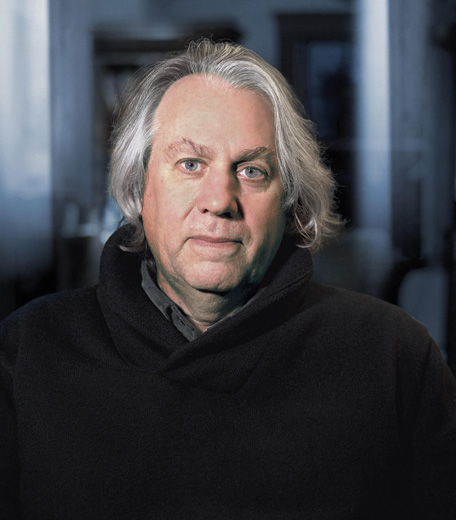Download
Acceptance speech
Kerry Emanuel
Kerry Emanuel (Cincinnati, Ohio, United States, 1955) holds an SB degree in Earth and Planetary Sciences (1976) and a PhD in Meteorology (1978) both from Massachusetts Institute of Technology.
After his doctorate, he took up an appointment in the Department of Atmospheric Sciences at the University of California, Los Angeles, where he remained for three years, except for a spell spent filming tornadoes in Oklahoma and Texas.
In 1981, he returned to MIT, where he has pursued his research and teaching career for little short of forty years. Since 1987, he has held the post of Cecil & Ida Green Professor of Atmospheric Science in the Department of Earth, Atmospheric and Planetary Sciences (EAPS). From 1989 to 1997, he headed the EAPS Center for Meteorology and Physical Oceanography, and from 2009 to 2012 chaired the EAPS Program in Atmospheres, Oceans, and Climate. His is co-founder (with Daniel H. Rothman) and currently Co-Director of the MIT Lorenz Center, created in 2010 as a climate think tank which fosters creative approaches to learning how climate works.
He has authored more than 200 scientific papers and several books, including Divine Wind: The History and Science of Hurricanes and What We Know about Climate Change.
“By understanding the essential physics of atmospheric convection,” says the committee, “he has unraveled the behavior of tropical cyclones – hurricanes and typhoons – as our climate changes.” His theories, they add, “predict the observed intensification of hurricanes and typhoons with global warming,” while his research, “has opened new approaches for assessing risks from weather extremes.”
For committee chairman Bjorn Stevens, Director of the Max Planck Institute for Meteorology, “it is hard to imagine an area of climate science where one person’s leadership is so incontestable.” Kerry Emanuel is a professor in the Department of Earth, Atmospheric and Planetary Sciences at Massachusetts Institute of Technology (MIT).
Hurricanes rank with earthquakes as the natural events causing most deaths and the heaviest economic losses. But when Emanuel began studying them, the underlying physics was still largely unknown. It was the work he did in the 1980s and 1990s that characterized them as heat engines, “massive, natural machines that convert the heat they extract from the ocean into wind energy,” explains Emanuel, whom the committee additionally singles out for his “extraordinary effectiveness in communicating the science of climate change to the public and policy-makers.”
Besides unraveling the mechanisms of how hurricanes develop, Emanuel was the first to link them with the warming of sea surface waters driven by climate change. His models currently predict a 5% increase in hurricane intensity, i.e., wind speed, for each one degree rise in ocean temperatures.
“Three degrees of warming would mean hurricanes 15% more intense, but that would actually triple if we talk about their destructive potential; in other words, with this three percent increase their power to wreak damage would increase by around 45%,” remarked Emanuel on the phone yesterday after hearing of the award.
“Today’s most intense hurricanes may have a wind speed at the surface of 85 meters per second, but by the end of this century, unless we curb greenhouse gas emissions, we could start to see speeds of up to 90-92 meters per second. A hurricane’s destructive potential is determined by its wind speed, so in fact the destructiveness of these storms for human populations would be considerably greater.”
A visionary prediction
Emanuel was exploring the link between hurricanes and global warming as early as 1987. In a widely cited paper in Nature he discussed “the changes in tropical cyclone frequency and intensity that might result from short-term man-induced alterations of the climate,” hypothesizing that we would likely face a jump in hurricanes’ destructive power if climate change could not be reined in.
For decades there was no way these predictions could be tested, largely, he admits, due to a lack of reliable data on hurricanes at global level. In recent years, however, satellite observations particularly have brought scientists round to a consensus on the issue.
“The weight of evidence supports the hypothesis that higher temperatures ramp up hurricane intensity. Nothing in science is bullet proof, but the models show it, the data are beginning to show it, and we hope to be able to prove it in the next few years as more observations come in.”
Hurricanes in the Mediterranean
Another of Emanuel’s predictions increasingly borne out by the data is that hurricanes will spread into more regions of the planet. For the Mediterranean, this will mean the appearance of “medicanes,” as they have come to be known; a phenomenon Emanuel studied, alongside researcher Romualdo Romero, during a sabbatical year spent at the University of the Balearic Islands (Mallorca) in 2005.
“In some sense we are already seeing the geographical expansion of hurricanes,” Emanuel points out. “Regarding the specific effect of climate change on “medicanes,” our observations indicate that, in effect, as the Mediterranean warms up, we would expect to see a higher incidence of this type of hurricane. They occur under rather different weather conditions to tropical cyclones, but they’re basically the same kind of storm.”
Not only that, a changing climate means hurricanes will develop more rapidly, becoming faster and more intense. And this, he warns, will complicate the already tough task of making accurate forecasts.
In light of these predictions and the escalating risk to humanity, the new laureate does not hesitate to affirm that, right now, the international community “is not doing nearly enough” to combat climate change. “Hurricanes are devastating. It is our responsibility to do everything reasonable that we can to reduce this risk. We need to stop listening to the voices of denial out there, and instead listen to our own children, who are crying out for us to act. To me it is shameful that so little is being done.”


